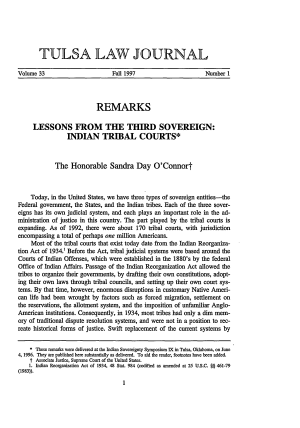By Justice Sandra Day O'Connor
Lessons from the Third Sovereign: Indian Tribal Courts
June 4, 1996

DISCLAIMER: This text has been transcribed automatically and may contain substantial inaccuracies due to the limitations of automatic transcription technology. This transcript is intended only to make the content of this document more easily discoverable and searchable. If you would like to quote the exact text of this document in any piece of work or research, please view the original using the link above and gather your quote directly from the source. The Sandra Day O'Connor Institute does not warrant, represent, or guarantee in any way that the text below is accurate.
Article Text
(Excerpt, Automatically generated)
Today, in the United States, we have three types of sovereign entities-the Federal government, the States, and the Indian tribes. Each of the three sovereigns has its own judicial system, and each plays an important role in the ad ministration of justice in this country. The part played by the tribal courts is expanding. As of 1992, there were about 170 tribal courts, with jurisdiction encompassing a total of perhaps one million Americans.
Most of the tribal courts that exist today date from the Indian Reorganization Act of 1934.1 Before the Act, tribal judicial systems were based around the Courts of Indian Offenses, which were established in the 1880's by the federal Office of Indian Affairs. Passage of the Indian Reorganization Act allowed the tribes to organize their governments, by drafting their own constitutions, adopting their own laws through tribal councils, and setting up their own court systems. By that time, however, enormous disruptions in customary Native American life had been wrought by factors such as forced migration, settlement on the reservations, the allotment system, and the imposition of unfamiliar Anglo American institutions. Consequently, in 1934, most tribes had only a dim memory of traditional dispute resolution systems, and were not in a position to recreate historical forms of justice. Swift replacement of the current systems by
- These remarks were delivered at the Indian Sovereignty Symposium IX in Tulsa, Oklahoma, on June 4, 1996. They are published
